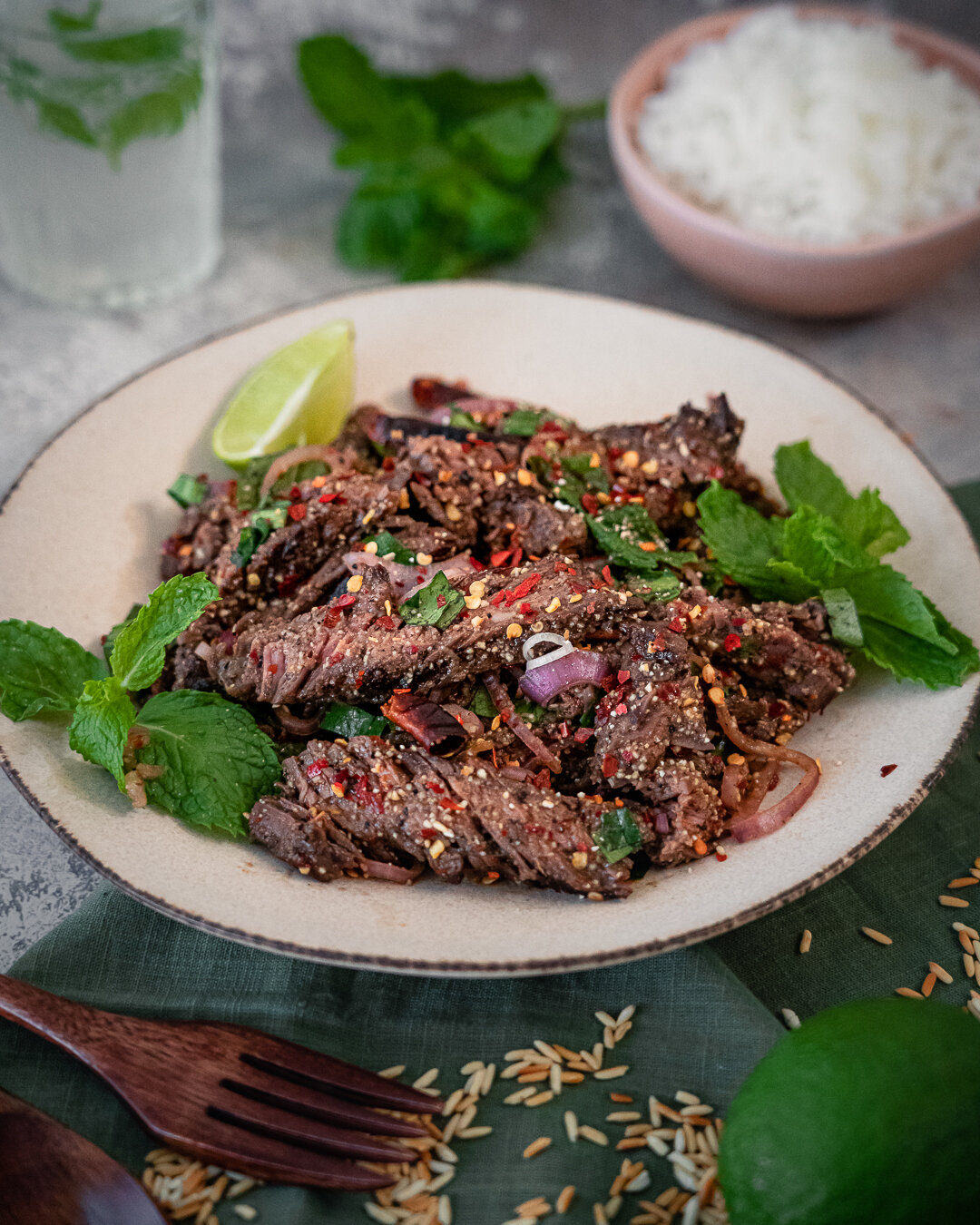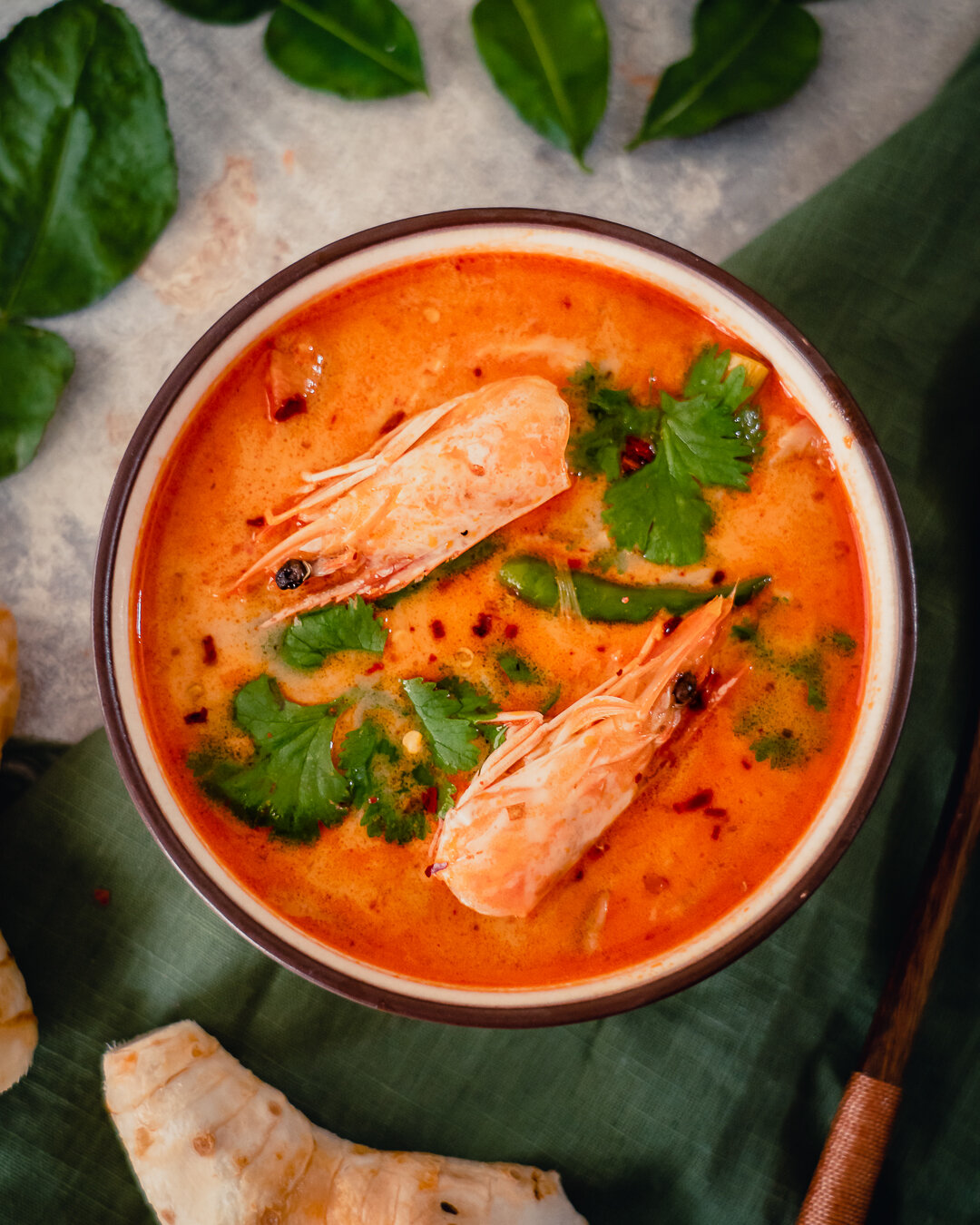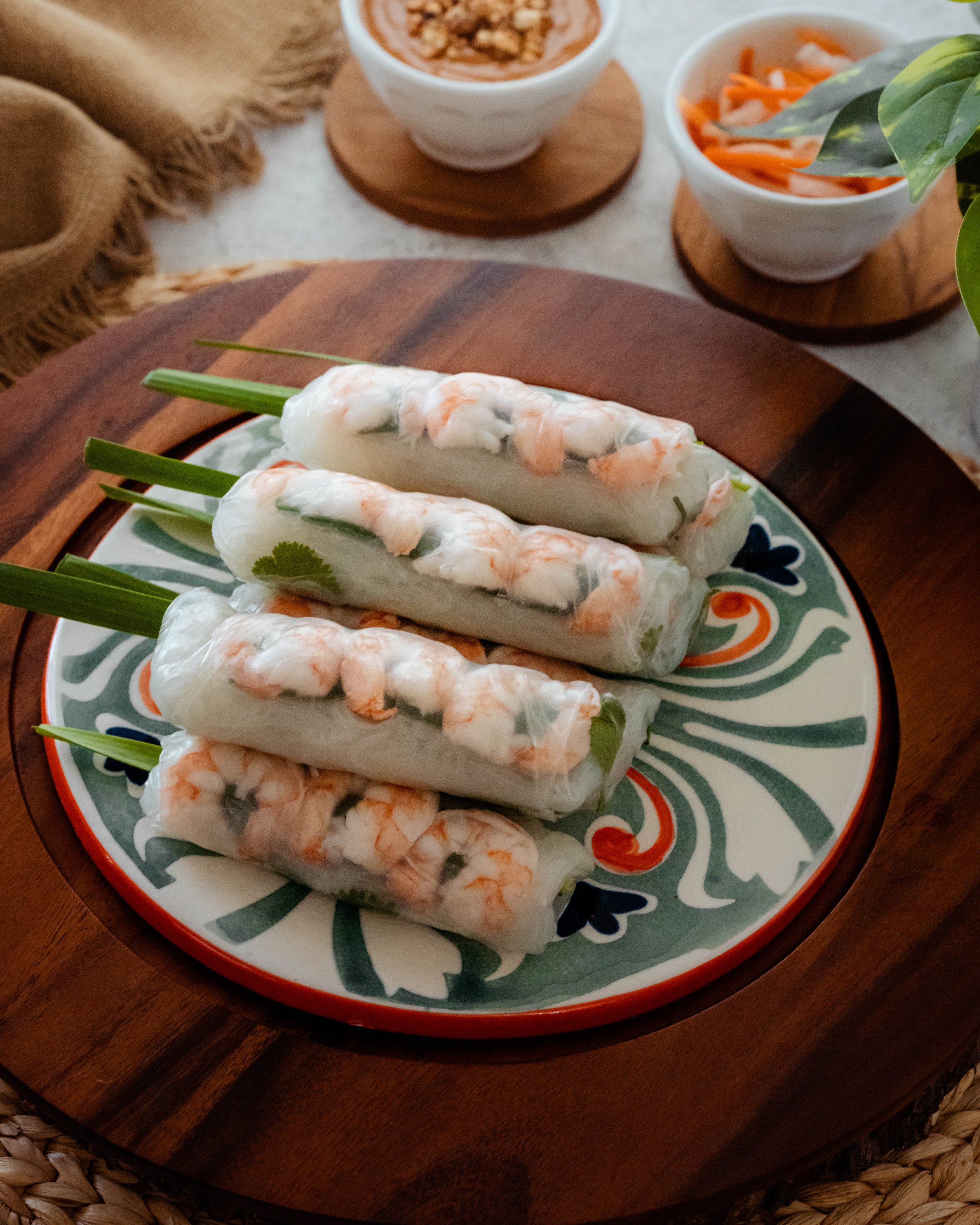Pad Thai

The original fast food of Thailand! Considered to be one of Thailand’s national dishes, a staple of Bangkok street food but also sold all over the country even in small, remote Thai villages. It is a dish that is ubiquitously Thai with roots that are as political as they are culinary. It was imposed upon the population almost 90 years ago as a cornerstone ingredient of a nationalistic agenda. A dish that was born out of a complicated era with a very unique culinary history and atypical ingredients.
Pad Thai is not a foreign creation like General Tso’s Chicken or Chicken Tikka Masala, yet it is the most popular Thai dish outside of Thailand. The flavor profile of pad Thai – sour, sweet, salty – makes it appealing to so many palates and encourage tourists to try Thai food. It is a very easy dish for a foreigner to order, and I think that’s why it moved so successfully to Thai restaurants in the West and became so popular overtime. Whenever we try Thai food, we try pad Thai first, because that is a way to judge how good a Thai restaurant is (at least that’s what we assume). What most of us don’t know is that this delicious concoction “Thai style stir-fried noodles” in the local vernacular is not historically a traditional dish in Thailand. It was born out of a necessity to instill patriotism and modernity among its’ citizens and maintain Thailand as an independent nation, out of the colonizers grasps.
History
In the 1930s, Thai prime minister Plaek Phibunsongkhram was committed to establishing a national identity to unite the nation through it’s local culture. This campaign mandated by Phibun included changing the country’s name, commissioning a new national anthem, and creating a new national dish – pad Thai. The goal was to enforce a hegemonic identity by changing the official name from Siam to Thailand, and banning local languages and dialects from the nation’s schools and unify the country by promoting a uniquely Thai dish.
Why noodles and not a rice dish in a county with so much rice in abundance?
Around the time of World War II, Chinese immigrants had made noodle dishes popular among Thai people. Phibun was trying to instill Thai patriotism and fight the spread of Chinese culture and culinary influence by enforcing traditional Thai ingredients and dishes. It can be seen as a paradox - using a Chinese ingredient like “noodles” to distance oneself or the entire country rather, from Chinese culture. Despite its Chinese origins, pad Thai stood out from the wet or dry noodle dishes sold by Chinese vendors. Instead of completely eliminating noodle dishes, the purpose was to redirect the locals to a noodle dish that used only Thai ingredients and flavors such as tamarind pulp and fish sauce. This is why pad Thai contains no ingredients common to other noodle dishes like soy sauce or oyster sauce. The heart of his campaign was to instill a love for Thailand and to stir up pride among the people in all things Thai by enforcing a cultural revolution.
But pad Thai wasn’t just about unity; it was also about nutrition. It was a dish born out of the post-war recession during which time people struggled to stretch every ingredient. During World War II, Thailand experienced a rice shortage due to the war and floods. It was a particularly difficult time economically for the country. Rice noodles were both cheap and filling, providing a much-needed antidote. A portion of rice noodles uses half as much of the grain when compared with a bowl full of rice, thus preserving the stock. Couple that with vegetables, bean sprouts, and inexpensive proteins, and it was the perfect, nutritious meal. Phibun devoted significant resources to Pad Thai’s promotion. The Public Welfare Department distributed recipes and a great number of free carts for selling pad Thai, which was accompanied by a ban on Chinese and other foreign food vendors as part of Phibun’s “Buy Thai” campaign. Propagandists under him also launched a campaign with the slogan “Noodle is your lunch”, thus forcibly boosting the consumption of pad Thai.
Traditional Pad Thai Ingredients
Pad Thai is such an ordinary dish that it is found everywhere in Bangkok, and these common ingredients are found right along with it. Everywhere. All the time. I have learned it's actually difficult to find good authentic pad thai in North America. This is possibly because some of the ingredients are hard to procure. Also most Thai restaurants are actually not Thai-owned and they want to cut costs and simplify the process.
But each ingredient in pad Thai contributes a flavor. Nothing in there is added just for “fluff” so the more you take away, the less complex the flavor profile becomes. There are certain ingredients you can omit and still have a decent plate of Pad Thai, but there are a couple ingredients that you cannot just remove or substitute, and if you do so, the flavor becomes very different from what Pad Thai actually is. All in all, pad Thai is a dish that may seem easy and quick to make but it requires pretty extensive preparation and very particular ingredients. I will discuss them more in detail below.
Ingredients that are must haves, absolutely no substitutions
Tamarind Paste - This cannot be substituted. There is no Pad Thai without some form of Tamarind pulp or paste. If you have tamarind at home, which from my knowledge most South Asian households do, you can make your own tamarind concentrate at home.
Fish Sauce - this is another ingredient with not much of a substitute. Feel free to use whichever brand that’s available to you. Unless you are allergic, do not leave out fish sauce.
Ingredients that have acceptable substitutes, at least here in the West
Palm Sugar - If you like cooking Thai food at home, I highly suggest buying palm sugar. Otherwise it can be substituted with light brown sugar.
Thai Chili Flakes - this depends on your tolerance for spice. If you cannot handle spicy food at all, just leave it out.
Peanuts - make sure they are unsalted, bonus if they come roasted but you can also dry roast them. If you are allergic or don’t like peanuts, just omit them. Although a little crunch does add nice texture, try roasted cashews, sunflower seeds or crumbled crispy fried onions.
Extra firm Tofu - the firmest tofu you can find. They come vacuum sealed and not the kind submerged in water, avoid those at all costs - they will crumble and disintegrate and ruin the Pad Thai. They are usually in the refrigerator section of most Asian grocery stores - yellow and beige in color or sometimes tinted dark brown (which are pre-seasoned and baked). If you can’t find extra firm tofu, get the firmest tofu you can find. If it comes floating in water, make sure to remove all the water from it - place it on a kitchen towel for half an hour, then wring out the towel, turn the tofu block upside down and again leave it on the towel for another half hour. If you do it right all the water will have seeped out of the tofu. Cut them in small bite size pieces and air fry them. If that’s too difficult, you can just leave out the tofu.
Dried Shrimp - this is an ingredient you will probably not find in Pad Thai served at most restaurants in the West, unless you have been to an authentic Thai owned restaurant. But in Thailand, this is a must. These little guys play a very important role in the dish and impart a lot of umami. If you are allergic, you can use dried scallops instead or just omit them.
Preserved Turnips - also known as salted/sweet pickled/preserved radish/turnips. Again, another ingredient a lot of restaurants leave out but it does add another layer of flavor which makes the pad Thai more authentic. There are two types of preserved radishes - salted and sweet. For pad Thai, you must use the sweet kind which is known as hua chai po waan. Try not to use the salty version because it will make the dish too salty. A good substitute for the Thai sweet preserved radish is Japanese sweet pickled daikon radish called Takuan.
Fresh Garlic Chives - also known as Chinese leeks or nira leaves. These are an easy find in Asian grocery stores. But if you can’t, scallions otherwise known as green onions work as an okay substitute. Garlic chives are more mild in flavor as they are considered vegetables, whereas green onion is a herb and adds more pungent flavor. If you are using green onions, add half the amount and cut them much smaller, like 1-2 inch small rings so the Pad Thai isn’t overpowered with their flavor.
Bean Sprouts - Pad Thai is a pretty rich dish packed with rice noodles and lots of proteins. Bean sprout is the only other vegetable aside from garlic chives, which adds texture, freshness and lightness to the dish. But if you don’t like bean sprouts, you can leave it out.
You can still make a decent Pad Thai even if you omit some of these ingredients. But if your goal is to create the Pad Thai as authentic as the ones sold on the streets of Bangkok or Thai owned restaurants, you probably should not leave them out and try to include as many ingredients as you can.
Recipe: Pad Thai
Serves: 2-3
Pad Thai has many key ingredients. It is made with rehydrated rice noodles, which are stir fried with eggs and chopped firm tofu, flavored with tamarind pulp, fish sauce, dried shrimp, palm sugar, garlic, shallots, red chili pepper, and served with lime wedges and chopped roasted peanuts. It also contains proteins such as fresh shrimp, chicken, beef, or other animal proteins as well as local vegetables like bean sprouts, garlic chives, pickled radishes or turnips, and raw banana flowers.
Timing is of utmost importance. Pad Thai is one of those dishes that needs to be cooked quickly so you have to prep all your ingredients ahead of time. Making Pad Thai isn’t hard; it does, however, require a fairly high level of concentration. You will need a wide wok or a big cast iron pan - anything with a large surface area and great heat retention which will allow for good evaporation so the dish does not end up being soggy.
Prepping all the Ingredients
The Noodles
Dry Rice Noodles - 4 oz, they should be thin and flat about 3-5mm in width
Soak the noodles in lukewarm water for 20 to 30 minutes. Once they are slightly tender cut noodles in half with scissors. This makes them easier to toss and separate during cooking. You will know the noodles are ready when they’re soft enough for you to twirl them around your fingers without breaking the strands. Then drain the noodles well and set them aside. Reserve a little bit of the starchy water from the noodles for the frying stage, if it requires more moisture.
Note: Be cautious during this step because you do not want to over soak the noodles. Pad Thai with overcooked and soggy noodles is just a big nope. If the noodles are wet, gummy and mushy, please start over. Never ever boil or blanch the noodles. They will melt and turn into rice glue.
The Sauce
Most people stress over the sauce and trying to find the right “balance”. Honestly, from personal experience the sauce is actually pretty easy. You can always tweak it and add more when serving the pad Thai. Check the notes below. If you’re going to worry a lot about something when it comes to Pad Thai, I am going to repeat myself…it’s the noodles.
Palm Sugar - 3 tbsp, or light brown sugar as a substitute
Water - 3 tbsp
Tamarind Paste - 3 tbsp
Fish Sauce - 3 tbsp
Roasted Thai Chili Flakes - 1 tsp
Chop the palm sugar very finely. Combine the palm sugar and water in a little saucepan over medium-low heat. Stir until sugar has dissolved. Let it come to a boil and stir frequently until it darkens in color. It will turn into a syrup like consistency once most of the water has evaporated. Add tamarind paste, fish sauce and chili flakes. Stir well, turn down the heat to low and let it simmer. After 5 minutes turn off the heat and let it rest.
Note: When it comes to Pad Thai sauce, this is the guideline or measurements I follow in accordance with the amount of noodles and protein. If you like it more sour, add more tamarind. If you like it saltier, add more fish sauce. If you like it sweeter, add more palm sugar or brown sugar. If you like it spicier, add more dried chili flakes. In addition, you can also have extra fish sauce, fresh lime, palm sugar and chili flakes on the table when serving the Pad Thai so each person eating can adjust the flavor for their plate of noodles. Think of this in equivalence to extra black pepper, or grated Parmesan like we do it in the West when it comes to eating pasta.
The Proteins
Boneless Chicken Breast or Thighs - 1 cup, sliced thin
Extra Firm Tofu - 4 oz cut into thin slices
Shrimp - 4-8 depending on the size
Clean and prep each protein. Set them aside.
Egg - 1
Whisk the egg and set it aside.
The Vegetables
Garlic Chives - 4 sprigs
Bean Sprouts - 1 cup
Wash the bean sprouts and garlic chives really well. Cut off the bottom of the garlic chives and only take the leaves. Now cut the chives the same length as the bean sprouts. Set them aside.
Note: If you are using scallions in place of the garlic chives, use only 2 sprigs and cut them into small rings. Include the bottom white parts to cook with the aromatics below and keep the green parts to use for garnish right as you are finishing up the Pad Thai instead of the garlic chives.
The Aromatics
Shallots - 1, diced
Garlic - 2 cloves, diced
Sweet Preserved Turnips - 1 tbsp, minced
Vegetable Oil - 2 tbsp
Prep and combine the shallots, garlic and preserved turnips. Set aside.
The Dry Ingredients
Roasted Thai Chili Flakes - 1 tbsp
Slow roast the chili flakes over low heat on a dry skillet for 5 to 7 minutes until they darken in color. Let them cool down completely. Set them aside.
Roasted Unsalted Peanuts - ¼ cup
Roast unsalted peanuts in the same dry skillet over low heat for 5 to 8 minutes. Let it cool down completely. Lightly crush the peanuts in a mortar and pestle and set aside
Dried Shrimp - 1 tbsp
Wash the shrimp well, then dry roast it on the skillet in medium heat for 5 minutes. Let it cool down. Using a spice grinder, blitz the dry roasted shrimp into a fine powder.
With the ingredients all prepped and ready, it is now time to cook the Pad Thai. This is a quick process so keep everything in hand ready.
Cooking the Pad Thai
Heat up a large wok or a large cast iron skillet over medium heat. Add just enough oil to coat the skillet. Sear shrimp, if you want you can season it lightly with a pinch of salt and chili flakes. Remove the shrimp and set it aside.
Add the remainder of the vegetable oil. Add shallots, garlic, sweet preserved turnips, and chicken. Once the chicken has turned color and looks slightly cooked, add tofu and dried shrimp powder. Sauté well until everything looks cooked. About 5 minutes
Turn the heat up to high and add the drained noodles to the skillet. Reserve some extra water from the soaked noodles in case. Using a tong and a spatula combine the proteins with the noodles. Once the noodle is no longer white, about 1 minute, add the Pad Thai Sauce. Coat the noodles well with the sauce.
Keep tossing until all the sauce is absorbed. Then lower the heat all the way and taste the noodles for doneness. If they’re still under-cooked, add a little more starchy water, about 1-2 Tbsp and continue cooking.
Once noodles are done, push them to one side of the pan. Add a little bit more oil to the empty space and add the whisked egg. Let it cook for about 30 seconds. The flip and toss to mix eggs into noodles.
Add the cooked shrimp, garlic chives, bean sprouts and half the ground peanuts. Turn off the heat and toss until it is mixed well.
Allow the Pad Thai about 10 minutes in the pan to cool down and absorb all the flavors. Then serve with a lime wedge and extra peanuts on top. For a classic presentation you can add a little extra side of bean sprouts, chili flakes and some garlic chives as garnish.
If you do recreate our recipe, be sure to
TAG & FOLLOW @TheSpiceOdyssey
Stay up to date with us on Instagram, Pinterest, Youtube and Facebook.










